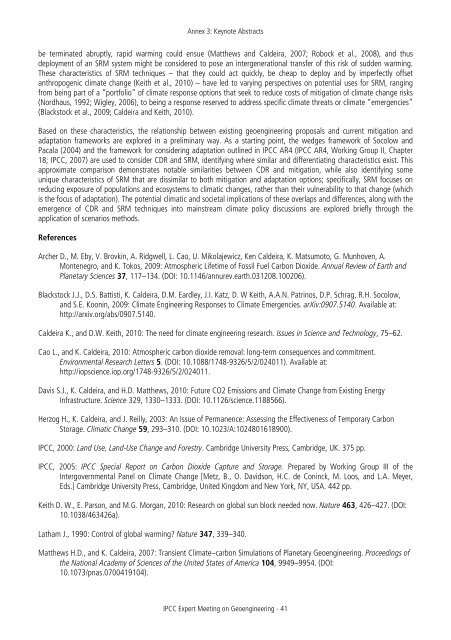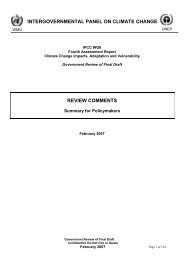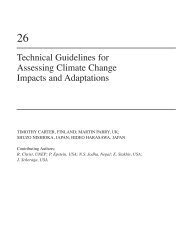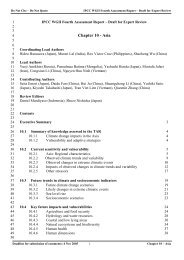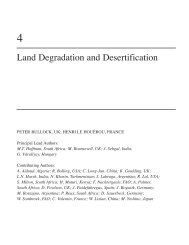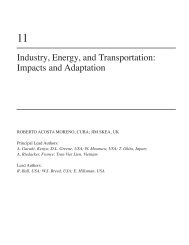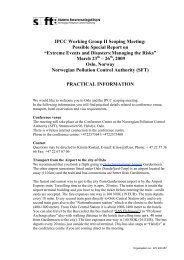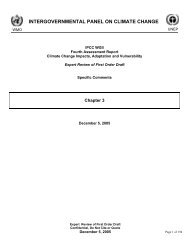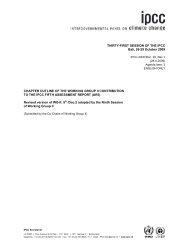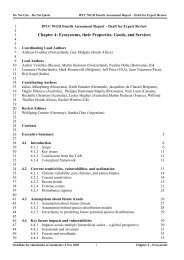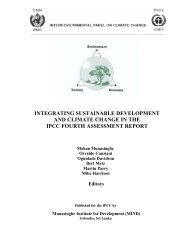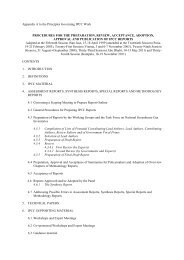IPCC Expert Meeting on Geoengineering
IPCC Expert Meeting on Geoengineering
IPCC Expert Meeting on Geoengineering
You also want an ePaper? Increase the reach of your titles
YUMPU automatically turns print PDFs into web optimized ePapers that Google loves.
Annex 3: Keynote Abstracts<br />
be terminated abruptly, rapid warming could ensue (Matthews and Caldeira, 2007; Robock et al., 2008), and thus<br />
deployment of an SRM system might be c<strong>on</strong>sidered to pose an intergenerati<strong>on</strong>al transfer of this risk of sudden warming.<br />
These characteristics of SRM techniques – that they could act quickly, be cheap to deploy and by imperfectly offset<br />
anthropogenic climate change (Keith et al., 2010) – have led to varying perspectives <strong>on</strong> potential uses for SRM, ranging<br />
from being part of a “portfolio” of climate resp<strong>on</strong>se opti<strong>on</strong>s that seek to reduce costs of mitigati<strong>on</strong> of climate change risks<br />
(Nordhaus, 1992; Wigley, 2006), to being a resp<strong>on</strong>se reserved to address specific climate threats or climate “emergencies”<br />
(Blackstock et al., 2009; Caldeira and Keith, 2010).<br />
Based <strong>on</strong> these characteristics, the relati<strong>on</strong>ship between existing geoengineering proposals and current mitigati<strong>on</strong> and<br />
adaptati<strong>on</strong> frameworks are explored in a preliminary way. As a starting point, the wedges framework of Socolow and<br />
Pacala (2004) and the framework for c<strong>on</strong>sidering adaptati<strong>on</strong> outlined in <str<strong>on</strong>g>IPCC</str<strong>on</strong>g> AR4 (<str<strong>on</strong>g>IPCC</str<strong>on</strong>g> AR4, Working Group II, Chapter<br />
18; <str<strong>on</strong>g>IPCC</str<strong>on</strong>g>, 2007) are used to c<strong>on</strong>sider CDR and SRM, identifying where similar and differentiating characteristics exist. This<br />
approximate comparis<strong>on</strong> dem<strong>on</strong>strates notable similarities between CDR and mitigati<strong>on</strong>, while also identifying some<br />
unique characteristics of SRM that are dissimilar to both mitigati<strong>on</strong> and adaptati<strong>on</strong> opti<strong>on</strong>s; specifically, SRM focuses <strong>on</strong><br />
reducing exposure of populati<strong>on</strong>s and ecosystems to climatic changes, rather than their vulnerability to that change (which<br />
is the focus of adaptati<strong>on</strong>). The potential climatic and societal implicati<strong>on</strong>s of these overlaps and differences, al<strong>on</strong>g with the<br />
emergence of CDR and SRM techniques into mainstream climate policy discussi<strong>on</strong>s are explored briefly through the<br />
applicati<strong>on</strong> of scenarios methods.<br />
References<br />
Archer D., M. Eby, V. Brovkin, A. Ridgwell, L. Cao, U. Mikolajewicz, Ken Caldeira, K. Matsumoto, G. Munhoven, A.<br />
M<strong>on</strong>tenegro, and K. Tokos, 2009: Atmospheric Lifetime of Fossil Fuel Carb<strong>on</strong> Dioxide. Annual Review of Earth and<br />
Planetary Sciences 37, 117–134. (DOI: 10.1146/annurev.earth.031208.100206).<br />
Blackstock J.J., D.S. Battisti, K. Caldeira, D.M. Eardley, J.I. Katz, D. W Keith, A.A.N. Patrinos, D.P. Schrag, R.H. Socolow,<br />
and S.E. Ko<strong>on</strong>in, 2009: Climate Engineering Resp<strong>on</strong>ses to Climate Emergencies. arXiv:0907.5140. Available at:<br />
http://arxiv.org/abs/0907.5140.<br />
Caldeira K., and D.W. Keith, 2010: The need for climate engineering research. Issues in Science and Technology, 75–62.<br />
Cao L., and K. Caldeira, 2010: Atmospheric carb<strong>on</strong> dioxide removal: l<strong>on</strong>g-term c<strong>on</strong>sequences and commitment.<br />
Envir<strong>on</strong>mental Research Letters 5. (DOI: 10.1088/1748-9326/5/2/024011). Available at:<br />
http://iopscience.iop.org/1748-9326/5/2/024011.<br />
Davis S.J., K. Caldeira, and H.D. Matthews, 2010: Future CO2 Emissi<strong>on</strong>s and Climate Change from Existing Energy<br />
Infrastructure. Science 329, 1330–1333. (DOI: 10.1126/science.1188566).<br />
Herzog H., K. Caldeira, and J. Reilly, 2003: An Issue of Permanence: Assessing the Effectiveness of Temporary Carb<strong>on</strong><br />
Storage. Climatic Change 59, 293–310. (DOI: 10.1023/A:1024801618900).<br />
<str<strong>on</strong>g>IPCC</str<strong>on</strong>g>, 2000: Land Use, Land-Use Change and Forestry. Cambridge University Press, Cambridge, UK. 375 pp.<br />
<str<strong>on</strong>g>IPCC</str<strong>on</strong>g>, 2005: <str<strong>on</strong>g>IPCC</str<strong>on</strong>g> Special Report <strong>on</strong> Carb<strong>on</strong> Dioxide Capture and Storage. Prepared by Working Group III of the<br />
Intergovernmental Panel <strong>on</strong> Climate Change [Metz, B., O. Davids<strong>on</strong>, H.C. de C<strong>on</strong>inck, M. Loos, and L.A. Meyer,<br />
Eds.] Cambridge University Press, Cambridge, United Kingdom and New York, NY, USA. 442 pp.<br />
Keith D. W., E. Pars<strong>on</strong>, and M.G. Morgan, 2010: Research <strong>on</strong> global sun block needed now. Nature 463, 426–427. (DOI:<br />
10.1038/463426a).<br />
Latham J., 1990: C<strong>on</strong>trol of global warming? Nature 347, 339–340.<br />
Matthews H.D., and K. Caldeira, 2007: Transient Climate–carb<strong>on</strong> Simulati<strong>on</strong>s of Planetary <strong>Geoengineering</strong>. Proceedings of<br />
the Nati<strong>on</strong>al Academy of Sciences of the United States of America 104, 9949–9954. (DOI:<br />
10.1073/pnas.0700419104).<br />
<str<strong>on</strong>g>IPCC</str<strong>on</strong>g> <str<strong>on</strong>g>Expert</str<strong>on</strong>g> <str<strong>on</strong>g>Meeting</str<strong>on</strong>g> <strong>on</strong> <strong>Geoengineering</strong> - 41


